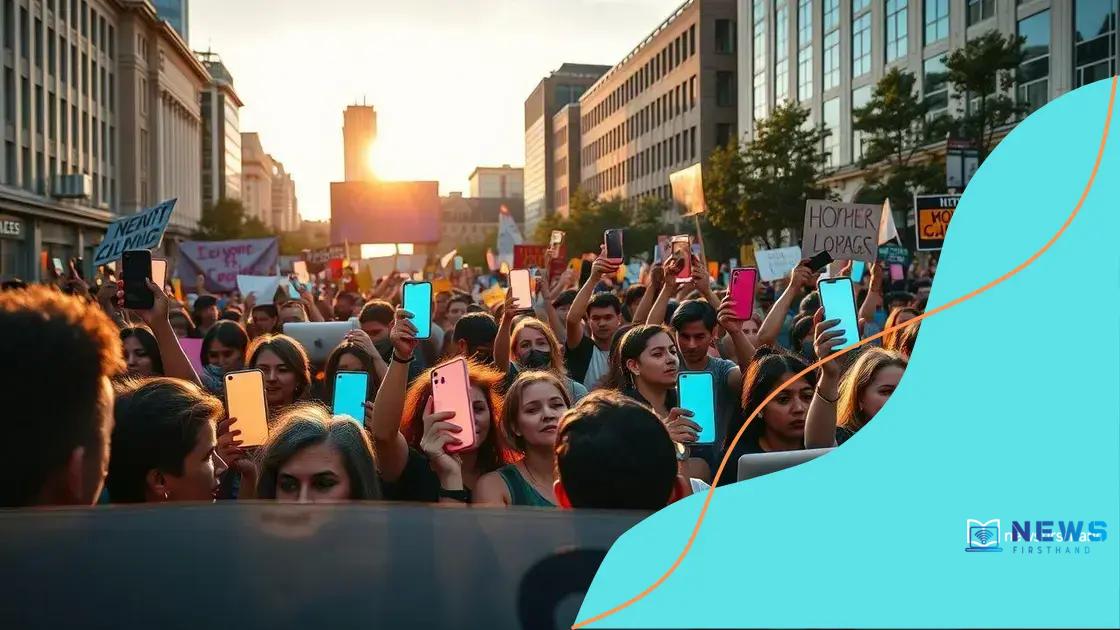Digital protest coordination platforms empower grassroots movements

Digital protest coordination platforms enable activists to organize efficiently, enhance communication, and mobilize support globally, playing a crucial role in modern movements such as Black Lives Matter and the Arab Spring.
Digital protest coordination platforms are transforming the way activists organize and mobilize for change. Have you ever wondered how these tools shape the dynamics of modern protest? Let’s dive into how technology empowers grassroots movements.
Understanding digital protest coordination platforms
Understanding digital protest coordination platforms is essential for anyone interested in modern activism. These platforms serve as vital tools that enhance communication and facilitate organization among participants. They simplify the way movements can rally support, share information, and plan actions.
Key Functions of Digital Protest Platforms
These platforms provide many functionalities that can significantly change the landscape of activism. They often include features such as:
- Real-time communication channels
- Event planning and scheduling tools
- Secure messaging systems
- Resource sharing capabilities
Through these features, activists can stay connected and organized, helping to maximize their impact. Participants can engage with each other seamlessly, promoting a sense of community and shared purpose.
The Role of Technology in Activism
Technology plays a crucial role in the effectiveness of protest coordination. Digital platforms allow for broad outreach, making it easier for people to connect across geographic boundaries. This connectivity brings together diverse groups, amplifying voices and fostering collaboration.
Additionally, many platforms allow for the integration of social media, which can be used to spread messages swiftly and reach larger audiences. Furthermore, digital protests can be organized with minimal logistical barriers, enabling more individuals to participate.
However, with these advancements come challenges. Some platforms may face issues related to privacy and security. Activists must remain vigilant and ensure their communications are protected from surveillance. Adopting practices that prioritize safety is essential for maintaining the integrity of these movements.
As the landscape of activism evolves, understanding the intricacies of digital protest coordination platforms will empower individuals to advocate for change. Engaging with these tools can lead to more effective and impactful movements that resonate on a global scale.
Key features of effective coordination tools
Key features of effective coordination tools are crucial for enhancing the success of digital protests. These tools equip activists with the necessary resources to stay organized and connected. Understanding these features can lead to more effective activism.
Essential Features
Effective coordination tools should include several critical elements that streamline the planning process. Key features may consist of:
- User-friendly interfaces that are easy to navigate
- Options for collaboration among team members in real time
- Tools for event management and scheduling
- Data security measures to protect participant information
These features enable groups to quickly adapt and respond to changing circumstances. The ability to communicate effectively is vital, especially in fast-paced environments where time is of the essence.
Integration with Social Media
Another important aspect is how well these tools integrate with social media platforms. Seamless sharing capabilities allow participants to spread the word about upcoming events, engage supporters, and amplify their message. This integration helps to tap into a broader audience, making it easier to gather support for a cause.
Moreover, having access to analytics features can provide insights into engagement levels and audience reactions. Understanding how supporters interact with content can help refine strategies and improve future outreach.
Lastly, accessibility on various devices is crucial. Effective coordination tools should be available on smartphones, tablets, and computers. This flexibility ensures that participants can stay connected regardless of where they are, making it easier for people to join and contribute.
Impact of technology on protest movements

The impact of technology on protest movements is significant and continually evolving. It has transformed how activists organize, communicate, and reach broader audiences. Understanding this evolution is crucial for anyone involved in advocacy.
Enhancing Communication
One of the most profound effects of technology is its ability to enhance communication. With modern tools, participants can connect instantly, share ideas, and mobilize quickly. From group chats to social media platforms, technology provides avenues for swift information exchange. This real-time connectivity allows movements to adapt and respond effectively to situations as they arise.
Broader Reach and Engagement
Technology also facilitates a broader reach. Through social media, movements can connect with individuals worldwide, raising awareness about their causes. Activists can share videos, images, and live streams, engaging people on a personal level.
- Viral campaigns can generate immense visibility
- Hashtags help unify messages and organize campaigns
- Online donations make fundraising easier
- Global solidarity through shared experiences
These strategies can amplify a movement’s voice, making it clearer and more compelling. People feel inspired to participate, whether by sharing content or joining events, because they see the power of collective action.
Challenges with Digital Protests
Despite the advantages, technology brings challenges. Issues like misinformation can spread rapidly, potentially damaging movements. Activists must remain vigilant in verifying facts and sources. Additionally, reliance on technology can create vulnerabilities. Cybersecurity threats are real, and activists need to take steps to protect their information.
While technology enhances many aspects of activism, it requires careful navigation to avoid pitfalls. By staying informed and adaptable, movements can harness the full potential of technology for positive change.
Challenges faced by digital platforms
Digital platforms face various challenges that can affect their effectiveness in organizing protests. These challenges can be technical, social, and even political. Understanding these issues is vital for activists aiming to leverage technology in their advocacy efforts.
Security Concerns
One major challenge is the risk of cybersecurity breaches. Activists often share sensitive information, making them targets for hackers. When digital platforms are not adequately secured, personal data can be exposed, leading to serious consequences for users. This challenge requires constant vigilance and updates to security measures.
Misinformation and Trust Issues
Another pressing concern involves misinformation. False narratives can spread rapidly on digital platforms, undermining trust and causing confusion within movements. This can divert attention from the core issues and create divisions among supporters. Activists must actively work to verify information and educate users on identifying credible sources.
- Combatting misinformation is crucial for maintaining focus.
- Digital literacy should be promoted among users.
- Transparency must be prioritized to build trust.
- Regular updates and fact-checking can help counter false information.
Moreover, censorship can pose significant challenges for digital protest platforms. Governments may seek to limit online discussions or restrict access to information. In extreme cases, entire platforms can be shut down, stifling activism. As a result, activists must be aware of the legal landscape and prepared to adapt to changing conditions.
Accessibility and Inclusivity
Finally, the issue of accessibility cannot be overlooked. Not all potential activists have access to the latest technology or reliable internet connections. This digital divide can marginalize certain populations, making it harder for them to participate in movements. Addressing this challenge requires efforts to enhance access to technology and digital literacy training for all.
In dealing with these challenges, digital platforms must evolve continually. Adapting strategies to address these concerns will help ensure effective coordination and support for activist movements.
Case studies of successful digital protests
Case studies of successful digital protests provide valuable insights into how technology can amplify activism. By examining specific instances where digital tools played a key role, we can understand the elements that contributed to their success.
The Arab Spring
One of the most notable examples is the Arab Spring, a series of protests across the Middle East in 2010-2011. Social media platforms such as Facebook and Twitter were crucial in organizing demonstrations and mobilizing support. Activists used these platforms to share videos and updates, revealing the realities of their struggles to a global audience. The speed at which information spread helped galvanize international support and put pressure on regimes.
Black Lives Matter Movement
Another significant case is the Black Lives Matter (BLM) movement, which gained traction through digital platforms. Following the death of George Floyd in 2020, social media became a powerful tool for advocacy. Hashtags like #BlackLivesMatter and #JusticeForGeorgeFloyd went viral, drawing attention to systemic racism and police brutality. The movement effectively used live streams to share protests in real time, engaging supporters worldwide.
- The BLM movement successfully engaged a diverse audience through emotional storytelling.
- Online petitions and fundraising campaigns helped the movement gain resources and visibility.
- Digital tools allowed rapid mobilization for protests around the globe.
Case studies like these illustrate how digital protests can impact societal change. They highlight the importance of having a clear message and utilizing technology to reach a wider audience. The inclusion of multimedia elements, such as images and videos, adds a personal touch that resonates with viewers and encourages participation.
Climate Strikes
Additionally, the global climate strikes initiated by young activists demonstrate the power of digital organization. Influenced by Greta Thunberg, the movement used social media to spread awareness and promote school strikes. Students across various countries customized their messages while maintaining a cohesive global dialogue around climate change. This grassroots approach showcased the effectiveness of digital mobilization in drawing attention to urgent issues.
These examples reveal the potential of digital platforms in shaping movements. By fostering community and using targeted messaging, activists can drive change and influence public opinion.
FAQ – Questions About Digital Protest Coordination Platforms
What are digital protest coordination platforms?
Digital protest coordination platforms are online tools that help activists organize, communicate, and mobilize for social movements.
How do these platforms enhance communication among activists?
They facilitate real-time communication through chat features, social media integration, and information sharing, allowing for quick decision-making.
What challenges do activists face when using digital platforms?
Activists may encounter issues like cybersecurity threats, misinformation, and access inequalities that can hinder effective organization.
Can you give an example of a successful digital protest?
The Black Lives Matter movement utilized social media effectively to mobilize protests and raise awareness about racial injustice on a global scale.





